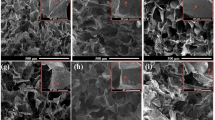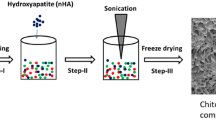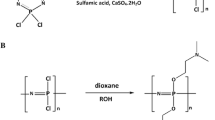Abstract
Currently, in bone tissue engineering research, the development of appropriate biomaterials for the regeneration of bony tissues is a major concern. Bone tissue is composed of a structural protein, collagen type I, on which calcium phosphate crystals are enclosed. For tissue engineering, one of the most applied strategies consists on the development and application of three dimensional porous scaffolds with similar composition to the bone. In this way, they can provide a physical support for cell attachment, proliferation, nutrient transport and new bone tissue infiltration. Hydroxyapatite is a calcium phosphate with a similar composition of bone and widely applied in several medical/dentistry fields. Therefore, in this study, hydroxyapatite three dimensional porous scaffolds were produced using the polymer replication method. Next, the porous scaffolds were homogeneously coated with a film of collagen type I by applying vacuum force. Yet, due to collagen degradability properties, it was necessary to perform an adequate crosslinking method. As a result, N-(3-dimethylaminopropyl)-N′-ethylcarbodiimide hydrochloride (EDC) and N-hydroxysuccinimide (NHS) was employed as an efficient and non-toxic crosslinking method in this research. The composites were characterized by means of SEM, DSC and TNBS. Furthermore, heparin was incorporated in order to accomplish sustained delivery of a growth factor of interest namely, bone morphogenetic proteins (BMP-2). BMP-2 binding and release of non-heparinized and heparinized scaffolds was evaluated at specific time points. The incorporation of heparin leads to a reduced initial burst phase when compared to the non heparinized materials. The results show a beneficial effect with the incorporation of heparin and its potential as a localized drug delivery system for the sustained release of growth factors.






Similar content being viewed by others
References
Rose FR, Cyster LA, Grant DM, Scotchford CA, Howdle SM, Shakesheff KM. In vitro assessment of cell penetration into porous hydroxyapatite scaffolds with a central aligned channel. Biomaterials. 2004;25(24):5507–14.
Hong Z, Zhang P, He C, Qiu X, Liu A, Chen L, et al. Nano-composite of poly(l-lactide) and surface grafted hydroxyapatite: mechanical properties and biocompatibility. Biomaterials. 2005;26(32):6296–304.
Ignjatovic N, Tomic S, Dakic M, Miljkovic M, Plavsic M, Uskokovic D. Synthesis and properties of hydroxyapatite/poly-l-lactide composite biomaterials. Biomaterials. 1999;20(9):809–16.
Kothapalli CR, Shaw MT, Wei M. Biodegradable HA-PLA 3-D porous scaffolds: effect of nano-sized filler content on scaffold properties. Acta Biomater. 2005;1(6):653–62.
Liao S, Wang W, Uo M, Ohkawa S, Akasaka T, Tamura K, et al. A three-layered nano-carbonated hydroxyapatite/collagen/PLGA composite membrane for guided tissue regeneration. Biomaterials. 2005;26(36):7564–71.
Maeda H, Kasuga T, Hench LL. Preparation of poly(l-lactic acid)-polysiloxane-calcium carbonate hybrid membranes for guided bone regeneration. Biomaterials. 2006;27(8):1216–22.
Kong L, Gao Y, Cao W, Gong Y, Zhao N, Zhang X. Preparation and characterization of nano-hydroxyapatite/chitosan composite scaffolds. J Biomed Mater Res. 2005;75(2):275–82.
Li XM, Feng QL, Cui FZ. In vitro degradation of porous nano-hydroxyapatite/collagen/PLLA scaffold reinforced by chitin fibres. Mater Sci Eng C-Biomim Supramol Syst. 2006;26(4):716–20.
Sachlos E, Gotora D, Czernuszka JT. Collagen scaffolds reinforced with biomimetic composite nano-sized carbonate-substituted hydroxyapatite crystals and shaped by rapid prototyping to contain internal microchannels. Tissue Eng. 2006;12(9):2479–87.
Zhu X, Eibl O, Scheideler L, Geis-Gerstorfer J. Characterization of nano hydroxyapatite/collagen surfaces and cellular behaviors. J Biomed Mater Res. 2006;79(1):114–27.
Pieper JS, Hafmans T, Veerkamp JH, van Kuppevelt TH. Development of tailor-made collagen-glycosaminoglycan matrices: EDC/NHS crosslinking, and ultrastructural aspects. Biomaterials. 2000;21(6):581–93.
Pieper JS, Oosterhof A, Dijkstra PJ, Veerkamp JH, van Kuppevelt TH. Preparation and characterization of porous crosslinked collagenous matrices containing bioavailable chondroitin sulphate. Biomaterials. 1999;20(9):847–58.
Pieper JS, van Wachem PB, van Luyn MJA, Brouwer LA, Hafmans T, Veerkamp JH, et al. Attachment of glycosaminoglycans to collagenous matrices modulates the tissue response in rats. Biomaterials. 2000;21(16):1689–99.
Pieper JS, Hafmans T, van Wachem PB, van Luyn MJA, Brouwer LA, Veerkamp JH, et al. Loading of collagen-heparan sulfate matrices with bFGF promotes angiogenesis and tissue generation in rats. J Biomed Mater Res. 2002;62(2):185–94.
Wissink MJB, Beernink R, Pieper JS, Poot AA, Engbers GHM, Beugeling T, et al. Immobilization of heparin to EDC/NHS-crosslinked collagen. Characterization and in vitro evaluation. Biomaterials. 2001;22(2):151–63.
Wissink MJB, Beernink R, Poot AA, Engbers GHM, Beugeling T, van Aken WG, et al. Improved endothelialization of vascular grafts by local release of growth factor from heparinized collagen matrices. J Control Release. 2000;64(1–3):103–14.
Wissink MJB, Beernink R, Scharenborg NM, Poot AA, Engbers GHM, Beugeling T, et al. Endothelial cell seeding of (heparinized) collagen matrices: effects of bFGF pre-loading on proliferation (after low density seeding) and pro-coagulant factors. J Control Release. 2000;67(2–3):141–55.
Steffens GCM, Yao C, Prevel P, Markowicz M, Schenck P, Noah EM, et al. Modulation of angiogenic potential of collagen matrices by covalent incorporation of heparin and loading with vascular endothelial growth factor.Tissue Eng. 2004:1502–9.
Yao C, Markowicz M, Pallua N, Magnus Noah E, Steffens G. The effect of cross-linking of collagen matrices on their angiogenic capability. Biomaterials. 2008;29(1):66–74.
Jiao YY, Ubrich N, Hoffart V, Marchand-Arvier M, Vigneron C, Hoffman M, et al. Preparation and characterization of heparin-loaded polymeric microparticles. Drug Dev Ind Pharm. 2002;28(8):1033–41.
Jiao YY, Ubrich N, Marchand-Arvier M, Vigneron C, Hoffman M, Lecompte T, et al. In vitro and in vivo evaluation of oral heparin-loaded polymeric nanoparticles in rabbits. Circulation. 2002;105(2):230–5.
Lee KW, Yoon JJ, Lee JH, Kim SY, Jung HJ, Kim SJ, et al. Sustained release of vascular endothelial growth factor from calcium-induced alginate hydrogels reinforced by heparin and chitosan. Transpl Proc. 2004;36(8):2464–5.
SchroederTefft JA, Bentz H, Estridge TD. Collagen and heparin matrices for growth factor delivery. J Control Release. 1997;48(1):29–33.
Teixeira S, Ferraz MP, Monteiro FJ. Biocompatibility of highly macroporous ceramic scaffolds: cell adhesion and morphology studies. J Mater Sci. 2008;19(2):855–9.
Edlund U, Dånmark S, Albertsson AC. A strategy for the covalent functionalization of resorbable polymers with heparin and osteoinductive growth factor. Biomacromolecules. 2008;9(3):901–5.
Teixeira S, Oliveira S, Ferraz M, Monteiro FJ. Three dimensional macroporous calcium phosphates scaffolds for bone tissue engineering. Key Eng Mater Trans Tech. 2008:947–50.
Yamamoto M, Tabata Y, Hong L, Miyamoto S, Hashimoto N, Ikada Y. Bone regeneration by transforming growth factor beta1 released from a biodegradable hydrogel. J Control Release. 2000;64:133–42.
Teixeira S, Rodriguez MA, Pena P, De Aza AH, De Aza S, Ferraz MP, Monteiro FJ. Physical characterization of hydroxyapatite porous scaffolds for tissue engineering. Mater Sci Eng C. 2009;29(5):1510–4.
Acknowledgments
This work was supported by the Portuguese Foundation for Science and Technology (FCT) PhD grant SFRH/BD/17139/2004 and project FCT - POCTI/SAU - BMA/56061/2004. The authors would also like to thank Jun Liu for the assistance in the release experiments.
Author information
Authors and Affiliations
Corresponding author
Rights and permissions
About this article
Cite this article
Teixeira, S., Yang, L., Dijkstra, P.J. et al. Heparinized hydroxyapatite/collagen three-dimensional scaffolds for tissue engineering. J Mater Sci: Mater Med 21, 2385–2392 (2010). https://doi.org/10.1007/s10856-010-4097-2
Received:
Accepted:
Published:
Issue Date:
DOI: https://doi.org/10.1007/s10856-010-4097-2




